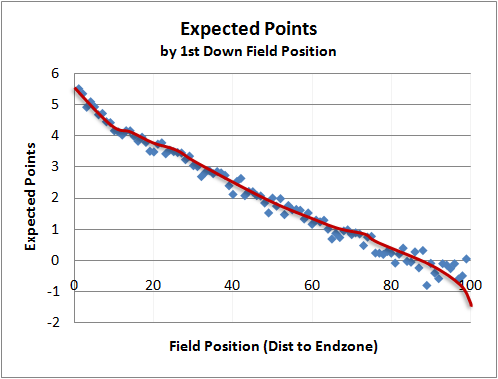I've always thought that a standard unwritten rule for punt returners is to plant yourself at the 10 yard line and let anything kicked over your head go into the end zone. Instead, I've observed many a punt returner attempt to return it from inside their own 10 (UNC's own Ryan Switzer would notoriously make me irate doing this). Are they making a negative risk/reward decision or am I wrong in my steadfast belief that it's a bad decision?
I gathered three full seasons of play-by-play data, using 2011-2013 (since that's what was readily available from this great Reddit thread for NCAAF data). There were almost 15,000 punt returns over this stretch, of which 1,387 were inside the 10 (9.3%). Whittling it further, 669 were actually fair caught (48%), leaving me with 718 punt returns that were caught inside the 10 yard line and returned.
The average punt meeting this criteria was caught at the 7.36 yard line and was returned for 8.98 yards, thus bringing the ball out to the 16.34 yard line. 76% of the time the returner gained yardage, while 12% of the time the returner lost yardage (the other 12% resulted in no gain).
Of the 718 returns, 10 times the punt was ran back for a touchdown (1.4%). On the flip side, 30 returners fumbled and lost the fumble (4.2%), and an additional 2 returns resulted in a safety (0.3%). On its face, it appears my intuition is correct: it's way more risky to try to run it back. But which option is optimal? Return it, fair catch it, or let it bounce towards the end zone?
I'll need to calculate the expected value for each possible scenario. A fair catch is the easiest: the offense takes over at the exact field position (on average for a fair catch, the 8.5 yard line), and I can use the same chart showing expected points from each part of the field to determine the expected points from 1st and 10 at the 8: -0.25 points.
Next up is the return. In my previous research, giving up a turnover in this part of the field results in an opposing touchdown 40% of the time, and a field goal the other 60%. So the expected value is:
4.2% (fumble lost) * ((60% * -3 (opposing field goal)) + (40% * -7 (opposing touchdown))) + 0.3% (safety) * -2 + 1.4% (touchdown) * 7 + 0.25 (expected points from 1st and 10 at the 16) = 0.15 points
The final piece is the murkiest: letting the ball go in hopes of a touchback, but running the risk of it being downed even deeper in your own territory. I looked at any punt in the dataset that was not returned or fair caught, and 41% of all punts met this criteria (were downed, went out of bounds, or were touchbacks). Of those that were downed inside the 10 or became touchbacks, 51.4% were stopped inside the 10 at an average of the 4.8 yard line, while the other 48.6% resulted in touchbacks. So the expected value in this scenario is:
51.4% (downed) * -0.5 (expected points from 1st and 10 at the 5) + 48.6% (touchback) * 0.5 (expected points from 1st and 10 at the 20) = -0.01 points
This expected value proposition thus results in the following ordering:
1. Return the punt: 0.15 points
2. Let the punt go: -0.01 points
3. Fair catch: -0.25 points
My original thoughts on the matter are dead wrong: returning the punt is the best of the three scenarios. Letting it go is better than making a fair catch, but returning the punt is the strictly dominant choice of the three options.

No comments:
Post a Comment